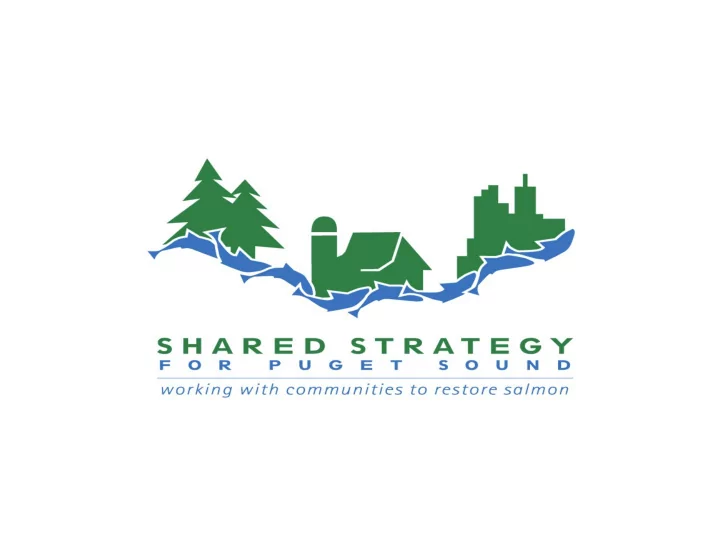

What is the Shared Strategy for Puget Sound? Unique approach to create a recovery plan by the communities affected and include the commitment for implementation.
Shared Strategy Goal Develop a practical, cost-effective recovery plan endorsed by the people living and working in Puget Sound
Shared Strategy Objective Recover and maintain an abundance of naturally spawning salmon at harvestable levels. Photo: courtesy of Mike Grayum One day listed salmon species can be as Abundant as these sockeye.
The Shared Strategy builds on and integrates with existing efforts… Hatcheries Harvest Habitat Forest and Fish Agreement GMA and CAO’s 2514 Watershed Planning
The Local Role in Recovery Planning Dungeness Nearshore Watershed Island County Nooksack Watershed Puget Sound ESU Recovery Plan
Recovery Plan Content • What it takes to achieve recovery • Measurable goals • Protection & restoration actions to achieve goals • Costs. • Implementation strategy • Commitments • Monitoring and adaptive management. Suquamish tribal biologist counts Chinook at Gorst Creek
Scientific and Political Certainty Certainty of results Certainty of from actions for: Implementation: Measurable Goals Abundance: #s of fish Robust implementation Productivity: population steps and schedule growth in future generations Decision-maker Spatial Structure : habitat involvement distribution Realistic cost estimates Diversity: variety of survival strategies (e.g. life histories, Commitments for sizes) implementation
Technical requirements •All populations and watersheds have to be improved. •All populations need to be out of current level of high risk. •Low risk for a populations means abundance and productivity is at 70-80 percent of history. •At least half of chinook populations need to be at low risk and dispersed around the region.
Challenges • Salmon are only part of the overall problems affecting Puget Sound and the rivers and streams draining into it. • Puget Sound orcas are proposed for listing • 37 animals living in Puget Sound are listed by the feds or state as threatened, endangered or a species of concern • 92,000 acres of mud and sand in the Sound are contaminated • Hood Canal has a “dead zone” • Numerous efforts need to move together, but to date there has not been unified public/political support to stem declines. • Projected human population growth (over 1.4M people by 2020 in addition to current 3.8M) • Costs and available funds; finite resources
Watersheds are delivering on our hopes •Identifying the causes of decline, threats and necessary actions. •Developing focused 10 year plans. •Prioritizing the most important projects. •Able to tie major actions to improvements for fish. •Costs.
Removing Barriers •Dams on the Elwha – miles of pristine habitat in Olympic National Park •Mid-fork Nooksack – 15% increase in abundance •Culverts in private, public forest lands and local roads
River
Protection of Marine and Freshwater Habitats • Seventy percent of watersheds in long-term resource management – 30 percent focus of human habitat. •Implementation of forest and fish agreement. •Strategies and incentives for agriculture. •Updates to Growth Management and Critical Areas Ordinances – increased conservation programs. •Oil spill prevention.
(looking northeast) South Elliott Bay
Working with Market Forces •Creating a sustainable agricultural system. •Forest stewardship. •Restoration as an economic resource. •Land development.
Ten Year Results • Habitat, harvest and hatchery efforts could increase the capacity - 20 percent improvement in conditions. • Fish response will take longer. • Requires at least a doubling of the efforts. • Next ten years is a critical time to get ahead of growth and take advantage of favorable ocean conditions.
Opportunities • Ability to build on past work and on region’s successful examples (e.g. Lake WA cleanup), • Many efforts on same timeframe: water quantity, hatchery reform, harvest improvements, Critical Areas Ordinance and Shoreline Management Act updates, forest HCP, local recovery chapters, • Our current science can better inform interactions between habitat, harvest, hatcheries. • Engaged local communities and elected officials, • The public cares about the environment and about economic prosperity; either/or choices no longer acceptable; need both/and solutions
One Region, One Strategy, One Plan • Shared Strategy with the watersheds is developing a comprehensive plan that will: • Set regional priorities and ensure independent efforts are well-coordinated, • Include a ten-year financing strategy, and • An implementation structure • The comprehensive plan will result in: • A unified approach to the Legislature and Congress for funding to implement the plan, • A rational, cost-effective approach to recovery • Increased certainty and stability
Shared Strategy Vision Together we can create a future in which both people and salmon co-exist and thrive. Life cycle graphic: King County
Recommend
More recommend